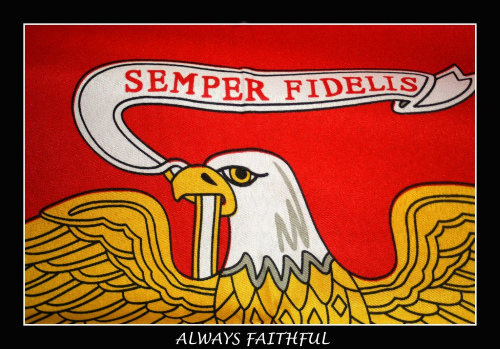“Semper Fi” holds a special place in the hearts of Marines.
The Marine Corps motto plays a significant role in the lives of every Marine and the history of the United States.
Additionally, we will talk about 11 other fascinating facts that will give you a better understanding of what it means to be a Marine.
But what is the significance of the Marine Corps motto?
Let us talk about it.
Related Article – 30 Marine Corps Sayings Explained
Table of Contents
#1. Semper Fi
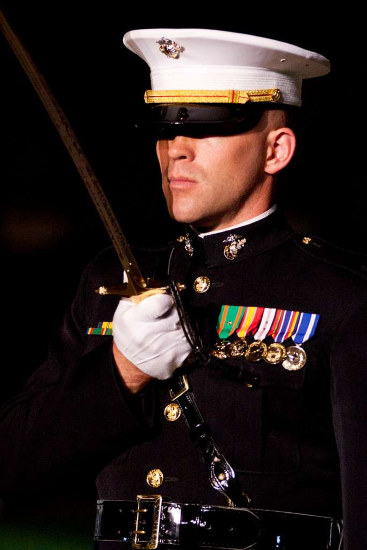
Semper Fi is short for Semper Fidelis, Latin for “Always Faithful.”
It is the official motto of the United States Marine Corps and embodies what it means to be a United States Marine.
The term was established in 1888 when John Philip Sousa wrote “Semper Fidelis” as the Marine Corps’ official march.
Marines don’t take the Semper Fi meaning lightly. It’s a reminder to service members and to the citizens of the United States of the Marine Corps’ undying faithfulness to its country, the men and women who serve, and devotion to future battlefields.
Marines embrace “Semper Fidelis” by facing adversity, maintaining an unbreakable bond with their comrades, and upholding the highest standards of honor and integrity.
It is more than a motto, but a lifelong message that resonates with those who served for the rest of their lives.
#2. Marine Navajo Code Talkers
Many lives were lost during World War II because of intercepted communications.
The opposition could still decode our communications, even with complex ciphers and attempts to encrypt messages.
To combat this, the United States Marine Corps selected 29 Navajo men in 1942 to use their language to relay combat essential communications.
The Navajo Code Talkers developed a complex system of communication that combined the traditional Navajo language with military terminology, making it virtually indecipherable to enemy forces.
The Navajo language was a complex language unknown by the Japanese, which allowed the Marine Corps to relay messages in 20 seconds compared to 30 minutes with conventional encoding methods.
Their efforts were critical to the Marine Corps’ success in the Pacific and saved countless lives.
#3. Devil Dog
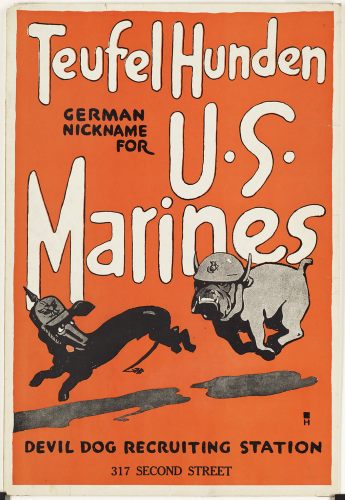
During the Battle of Belleau Wood in World War I, German Soldiers called Marines “Teufel Hunden,” which translates to Devil Dog in English.
Marines fought viciously on this French battlefield, which was one of the many reasons we got the nickname Devil Dogs.
The battle was grueling, and while attacking German soldiers, Marines were often drenched in sweat, foaming from the mouth, and fought with an intensity that the Marine Corps is known for.
On the battlefield, there was also a vast terrain covered in hills.
While fighting, German soldiers saw Marines attacking their position uphill while climbing the steep terrain on all fours.
Marines have this same intense fighting spirit today and will unleash their fury on our nation’s enemies.
#4. Official Mascot
One of the lesser-known facts about the Marine Corps is that it has an English Bulldog mascot.
The current mascot is Chesty XVI, and he comes from a long line of tradition that dates back over a hundred years.
He gets his name Chesty from the nickname of Lieutenant General Lewis Burwell “Chesty” Puller, the most decorated Marine in American history with a history of service from the Banana Wars to the Korean War.
Chesty XVI has earned the rank of Private First Class and two medals, The National Defense Service Medal and the Global War on Terrorism Medal.
The Secretary of the Navy promoted him to Private First Class on December 13, 2022.
Related Article – Marine Rifleman’s Creed
#5. The Marine Corps Band
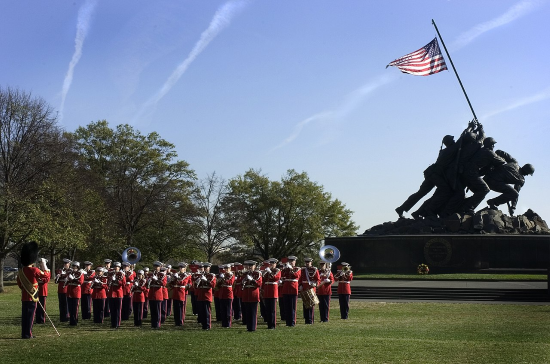
Established in 1768, the Marine Corps Band is the oldest active professional musical organization in U.S. history.
It is divided into three groups, Marine Corps Field Bands, The Drums and Bugle Corps, and the President’s Own.
The President’s Own is the most popular part of the Marine Corps band, and their mission is to perform for the President and the Commandant of the Marine Corps.
Nicknamed the “Commandant’s Own,” the Drum and Bugle Corps provides music and drill ceremonies for the Commandant and the Commanding Officer of Marine Barracks Washington, D.C.
The Field Band comprises the rest of the Marine Corps Band, where they perform for ceremonies and public events.
A lesser-known fact about the band is that their secondary mission is to provide security during combat operations.
However, members of the President’s Own do not attend recruit training, Marine Combat Training (MCT), or support combat missions.
The Marine Corps Band is also one of the most competitive occupational specialties to enlist, with multiple audition stages.
#6. Department of the Navy
The United States Marine Corps is a Department of the Navy, but this was not always the case.
The Marines were an independent service until 1834 when it became a Department of the Navy.
President Andrew Jackson wanted to make the Marines a part of the United States Army, but the Marine Corps mission did not fit.
That is when the commandant at the time, Archibald Henderson, pleaded his case to Congress that the Marine Corps should become a part of the Navy because it closely aligned its mission with its sister service, concentrating on amphibious operations.
Now, the Marine Corps and United States Navy are bound to support each other’s mission requirements and their unbreakable bond.
#7. Small Branch of the Military
The United States Marine Corps is one of the smallest branches in the Department of Defense.
It changes yearly based on mission requirements, but the Marine Corps has a little over 200,000 active duty and reservists.
In contrast, the Army has over 1,000,000 soldiers, including active duty, reservists, and National Guard.
The Marine Corps, known for their tenacity and adaptability, have long held the mantra “Marines do more with less.”
This principle highlights their exceptional ability to maximize limited resources and deliver outstanding results.
By fostering a culture of innovation and problem-solving, Marines consistently overcome challenges on and off the battlefield, making the Marine Corps an elite fighting force.
#8. The Eagle, Globe, and Anchor
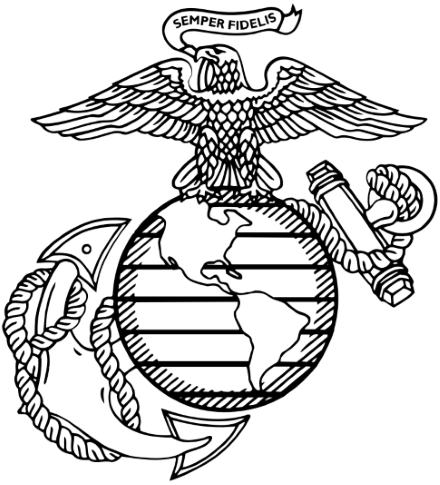
The emblem of the Marine Corps is the Eagle, Globe, and Anchor, and it is one of the most recognizable emblems of the United States Armed Services.
It represents the Marine Corps ethos, core values, and our mission.
Each component has a unique meaning that summarizes what it means to be a Marine.
The Eagle, an iconic representation of America’s freedom, signifies the steadfast vigilance and unwavering courage of the Marine Corps.
It also conveys the Marine Corps’ readiness to take flight in defense of the United States, which can also be seen on the eagle’s streamer with the inscription “Semper Fidelis.”
The Globe represents the global reach and presence of the Marine Corps.
It acknowledges the Marines’ role in promoting peace, security, and stability across the globe.
The Anchor represents the Marines’ roots with the United States Navy and their shared responsibility for defending our nation.
#9. Embassy Duty
The Marine Corps has close ties to the diplomatic community, with Marines providing security to over 150 embassies worldwide.
Marines made a formal arrangement in 1948 to provide security to diplomacy.
The Marine Security Guard’s (MSG) mission has a broad scope, including providing support during natural disasters and security during revolutions and civil unrest.
Marine Sergeants and below have the opportunity to serve in three geographical locations, while detachment commanders serve in two locations in three years.
In 2012, the Marine Corps established the Marine Security Guard Security Augmentation Unit (MSAU), which provides additional support during crises with a secondary mission of providing security for classified materials during VIP visits overseas.
#10. The Marine Corps Was Born in A Bar
This might not surprise you, but the Marine Corps was born in a bar.
The Marine Corps was established on November 10, 1775, in a bar named Tun Tavern in Philadelphia.
A committee of the Continental Congress understood the need for a specialized force that could provide maritime support during the Revolutionary War.
At its creation, there were only two battalions of Continental Marines, with Samuel Nicholas becoming the first commandant of the Marine Corps and Captain Robert Mullan as the first Marine Corps recruiter.
In celebration of our creation, Marines and those who served worldwide celebrate our birthday with the Marine Corps Ball.
It is a formal event filled with ceremony, celebration, and comradery.
Related Article – 194 Common Military Terms / Slang / Jargon / Lingo
#11. Oldest Weapon in Active Service
The United States Marine Corps has the oldest weapon in active service.
While not used in combat, the Mameluke Sword is still carried by officers for ceremonial duties.
During the First Barbary War in 1805, First Lieutenant Presley O’Bannon led a small detachment of Marines on a successful mission to overthrow the Tripolitan city of Derna.
His mission was to defeat the pirates of Tripoli and rescue the captured crew of the USS Philadelphia.
In recognition of his exceptional leadership and bravery, a chieftain in northern Africa gifted O’Bannon with the Mameluke sword.
By 1825, all Marine Corps officers carried the Mameluke sword, which represents the bravery and success of the Marine Corps on its first foreign deployment success.
Conclusion
The United States Marine Corps is an elite fighting force known for its bravery, dedication to national defense, and traditions.
Its motto, “Semper Fidelis,” is Latin for “Always Faithful,” which every Marine embodies with their dedication to the success of the United States and their victory over its adversaries.
You should now better understand the Marine Corps, its traditions, and its rich history.
Featured Image Source – www.Flickr.com
- 10 Best Tactical Vests - June 24, 2024
- 7 Best Tactical Fanny Packs For Concealed Carry - June 20, 2024
- 10 Best Military Tactical Sunglasses - June 20, 2024

